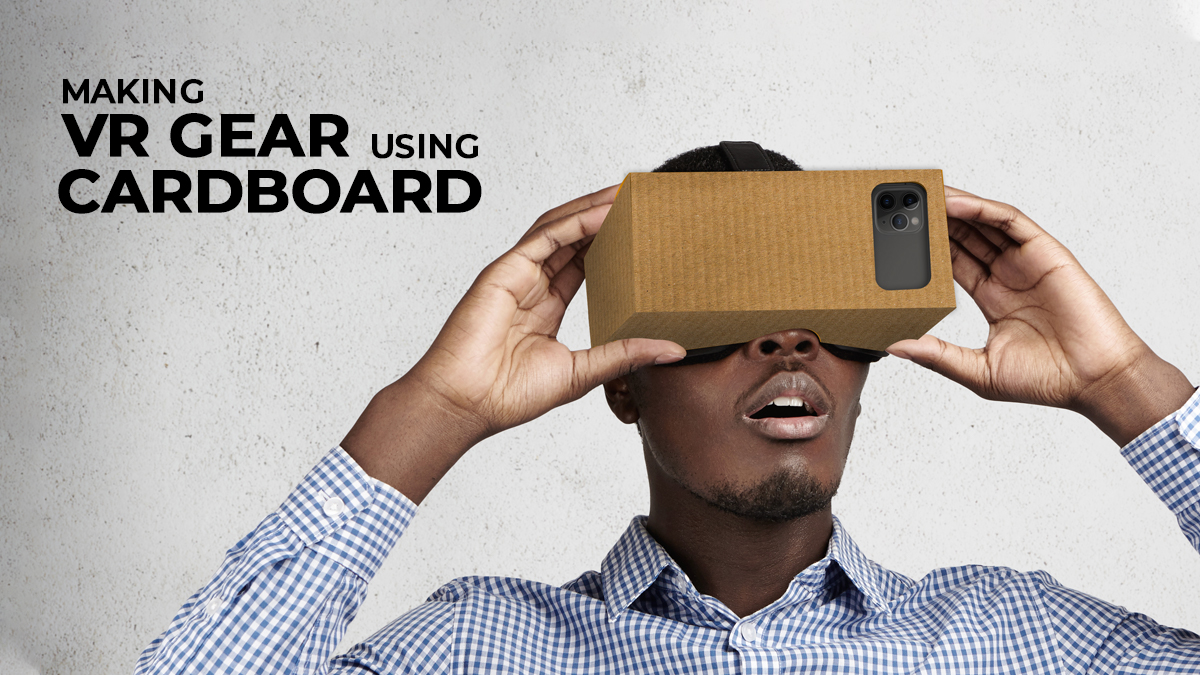
This article is the report for my Global Sustainability assignment which is an interactive workshop-based program to engage with important issues concerning sustainable innovation and ideas management. The idea for this assignment should be relevant towards design subject and it must be logical and functional.
This post explains how you can make a VR gear out of cardboard boxes and how such a conversion would help the global sustainability.
- Research date: November 2020
- Assignment: CW2 Global Sustainability – Reuse of Materials
- Major: Digital Marketing – RKL + Coventry University
What is Sustainability
Sustainability is to meet our own needs without compromising the ability of future generations to meet their needs. Sustainability also means that we keep the balance for use of our natural resources as well as our social and economic resources considering the needs of our future generations.
In the ecological, human, and economic context, the idea of sustainability promotes health and prosperity. In view of long-term objectives and the consequences of how resources are used, sustainability assumes that resources are scarce and should be used responsibly. It also recognises, on the other hand, the equality and implications of the use of these limited resources (McGill, 2019).
Why Cardboard Boxes
Cardboard boxes are a very common waste almost everywhere in the world. The rate is also high in Malaysia. Malaysians generated a whopping 38,142 tonnes of waste per day in 2018. Almost 26% of this amount of waste is made of papers and cartoon boxes (Chu, 2019).
The usage and throwing of cardboard boxes are very common because cardboard boxes are usually being used as the main material for packaging of all goods. A cardboard box is usually made of papers which are from trees. In order to produce cardboard boxes, industries have to cut trees and turn them into papers and cardboards. This process can be against sustainability and harm nature as making one ton of virgin cardboard requires three tons of trees (Earth911, 2020).
Luckily, cardboard boxes and papers can be recycled when they are properly managed as waste. The rate of recycling and recovery of this material as waste is not great. Paper recovery rates in Malaysia are still considered low at around 40%. Of about 250,000 tonnes of papers a year, Only 100,000 tonnes are recovered from the waste stream. A large balance is yet to be recycled (Thanam, 2020). As for the cardboard boxes, this rate is estimated to 33% of recyclables of Malaysian industries based on weight of recyclables. Infact, only between 2 to 6 percent of cardboard boxes are being recycled in Malaysia where the remaining are rejected to be recycled due to the poor quality of the waste and they will go for incineration or will be thrown away to landfill sites as waste (KPKT, 2020).
Even though recycling is a good idea and helps sustainability, it consumes energy and resources to make the waste usable again and sometimes the consumption of energy and resources can be even more than original production’s (Howard, 2018).
When cardboard boxes are recycled, they can be used to make chipboards like cereal boxes, paperboard, tissues, paper towels, and printing or writing paper (Waste Management).
Cardboard boxes can damage nature as waste if they are not properly managed. They can contain dangerous and toxic substances such as Chlorine, which is usually used for bleaching in producing cardboard boxes and DIBP which is a dangerous chemical substance that are available in inks for printing on cardboard boxes (Beach, 2019).
This can have a negative impact on our environment and cause issues such as water pollution, air pollution and impact on wildlife populations as well causing cancer in humans.
Using cardboard boxes for packaging can be costly. The cost of the packaging as a percentage of total selling price varies greatly. This cost ranges from 1.4 percent to 40 percent (Berger, 2020). This means that money is being thrown away when a product’s package is thrown away as a waste.
Idea Development
Product Idea
A Virtual Reality gear (aka VR headset) is a head-mounted gadget that provides virtual reality experience for the user. VR gears are widely used with video games but they are also used in other applications such as trainers and simulations. These gears are basically a wearable head-mounted device that lets you experience virtual reality either with a connection through a phone or a computer/console (PC Magazine, 2020).
This idea will turn cardboard boxes to Virtual Reality (VR) headsets that can be used to convert mobile phone screens to VR glasses. This will help smartphone owners to experience virtual reality using their handphones in an affordable way by just reusing their cardboard boxes that are waste.
VR gears and headsets are usually made of plastic and synthetic organic compounds that are not sustainable when used by a single user and their lifespan is about 2-3 years as they are not upgradeable, which means once VR technology is upgraded, your device can only be working with the previous technology and in order to go with the latest one, the user need to buy a new one supporting the latest technology.
The conversion of cardboard boxes to VR headset will allow you to make a VR gadget tailored to the latest VR technology standards and when it’s outdated, make a new one or upgrade the current one to the latest technology using cardboards and with a very low cost.
Development
To reuse cardboard boxes and make a DIY VR headset, you will need some simple tools and materials that can be found in any house. These tools and materials are Scissors, cutter knife, glue, tape and a ruler.
Thicker cardboard boxes will have better stability when converted to a VR gear. If the cardboard box is not thick, having more layers of cardboard can be used for each part to make it stronger and more stable.
The outcome of the conversion will be a VR gadget which can turn a mobile phone screen into a VR view screen when it’s held or worn.
Sizes & Dimensions
This VR gear can be made in two size variations, one for adults and one for children – since children usually have smaller skull size. Here are the size specifications for both adult and children models:
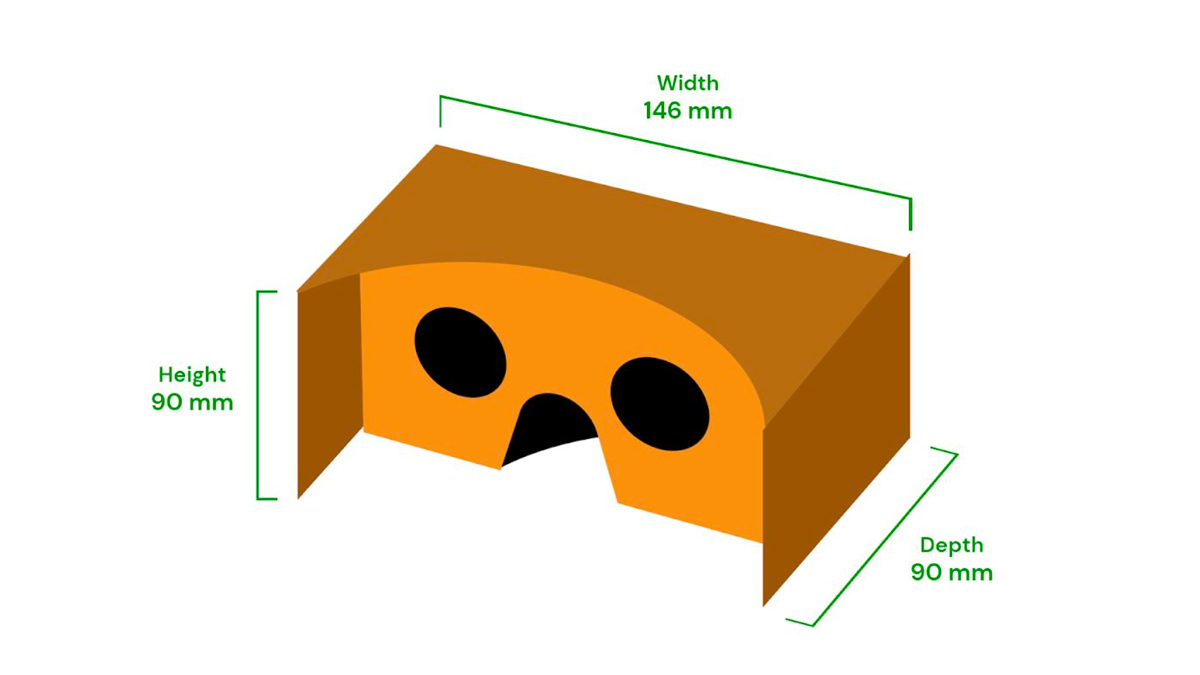
| Dimensions | Adult Size | Child Size |
|---|---|---|
| Width | 186 mm | 168 mm |
| Height | 80 mm | 80 mm |
| Depth | 90 mm | 90 mm |
Required Materials & Tools
Materials
Cardboard Box (Gadget Body)
Cardboard boxes will be used as the main material for the gear body. The thicker and corrugated cardboard sheets are recommended.
- Minimum size: 300 mm x 600 mm
- Preferred thickness: 1.5 mm or thicker
Supplementary Materials
Water Bottle (Lenses)
A plastic water bottle will be used to create the lenses of the VR gear. A clear water bottle would be better as it will give the user a clearer vision.
Rubber Band (Body Holder)
A rubber band can be used to secure the phone from sliding out.
- Quantity: Min. 1
- Minimum length: 80 mm
Velcro (Cap holder) [Optional]
Velcro stickers can be used to make the top part more stable – especially for the front part where it hold the phone inside the body.
- Minimum length: 6cm/li>
Cutter Knife
A sharp and precise cutter knife is recommended to cut the cardboard box and make the VR gear parts out of it.
Scissors
Sharp scissors can help you cut the small parts such as flabs and lens holes, as well as lenses themselves.
Ruler / Measuring Tape
A ruler or a measuring tape to be used for measurement when cutting the cardboard box and making the parts.
Glue / Tape (Optional)
Using glue or tape will help the parts stick together and be more stable when in use.
Sizes & Dimensions
Lens Holders
To create the inside part which is the divider between the phone and the user’s head, you need to cut all the layers of this part at the same time and preferably attached together. This part needs to have three layers for holding the lenses in between the first and the last layer and the strength of these three layers will help the stability of the gadget.
To prepare this part, follow the cutting lines on a cardboard box with the given dimensions and sizes:
- Height of each layer: 80 mm
- Width of each layer: 138 mm
- Diameter of lens holes: 30 mm
- Width of wings/flaps: Min. 20 mm
- Height of nose cut: 34 mm
Cutting
The inside part needs to be cut as the following template. The dimensions need to be followed accurately. For the best outcome, the given template can be printed and pasted on the cardboard box surface so the cutting and folding lines are precise.
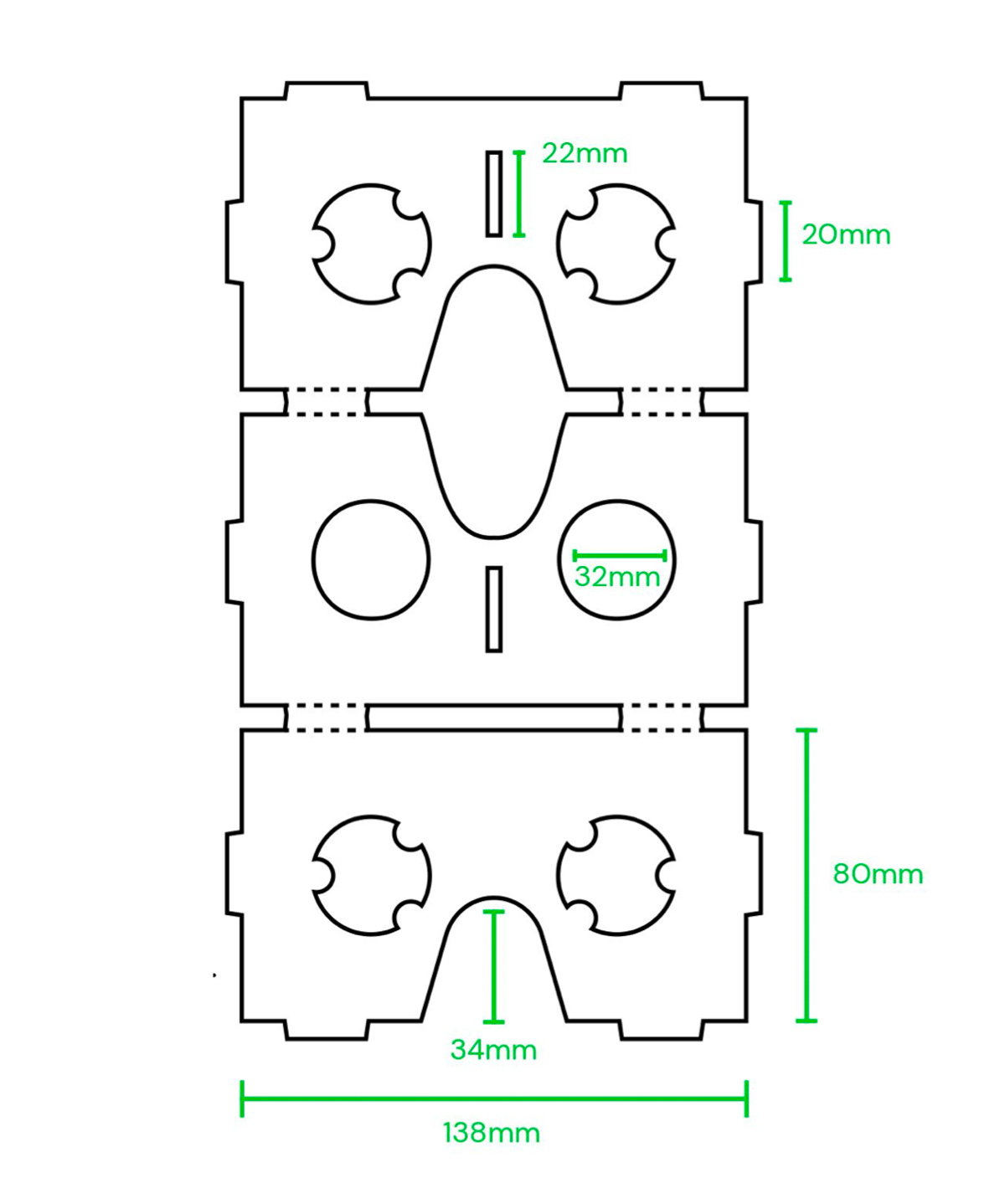
Folding
This part should be folded correctly as the following figure:
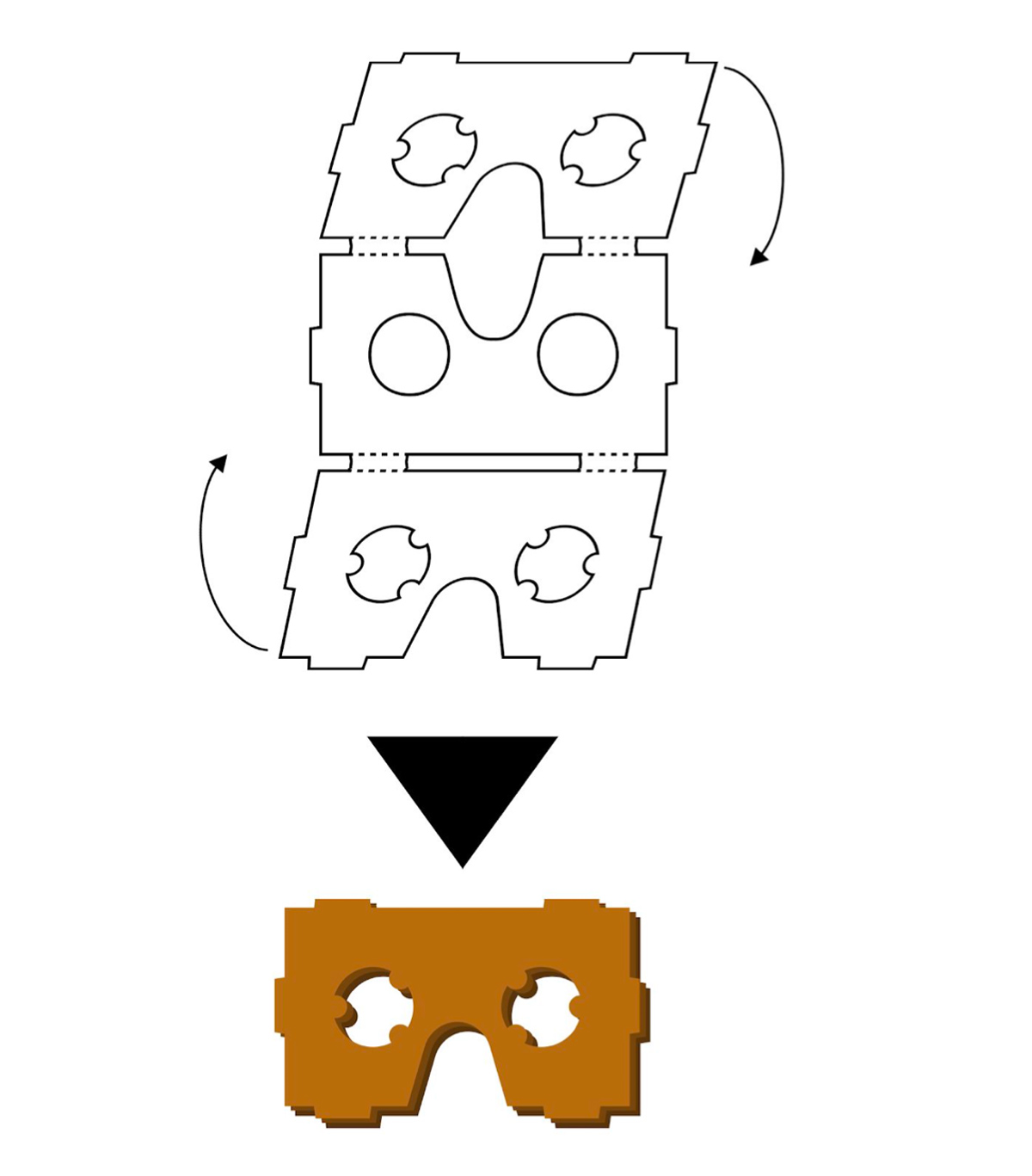
Lenses
To make the lenses, you will need one or two plastic bottles of water (depending on the size of the bottle). There are 2 two lenses needed, which means 4 lens parts need to be cut.
Cutting
Cutting needs to be done on the part of the plastic bottle where the curvy part is. Follow the instruction below for cutting and assembling the lenses
- Diameter of lens holes: 35 mm
- Number of pieces: 4
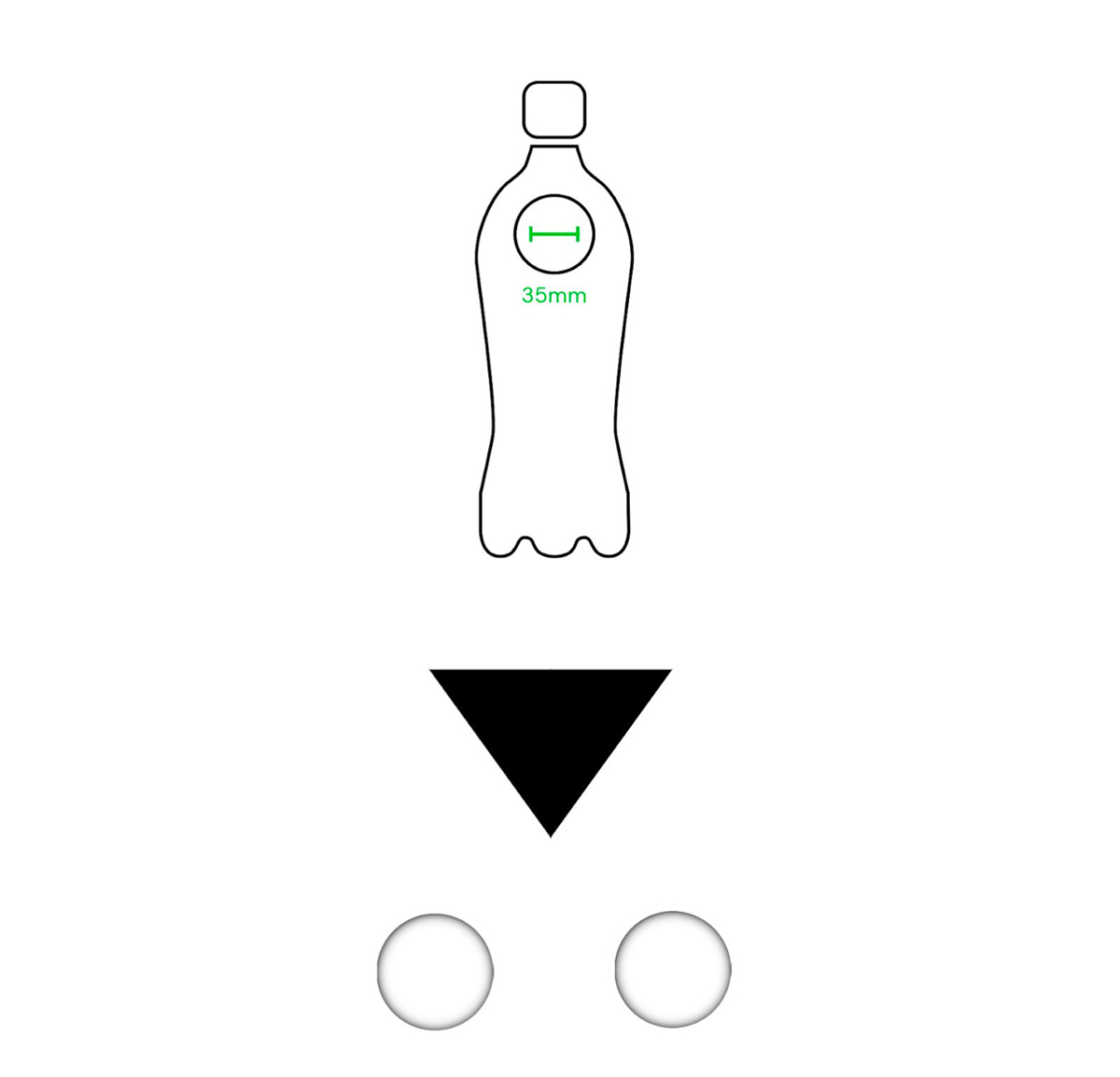
Lenses need to be placed in the middle layer of the lens holders
Body Part
The body part which holds the phone and provides the whole functionality of a VR gear.
- Maximum height of side parts: 90 mm
- Width of top and bottom parts: 148 mm
- Diameter of lens holes: 30 mm
- Width of wings/flaps: Min. 20 mm
- Height of nose cut: 34 mm
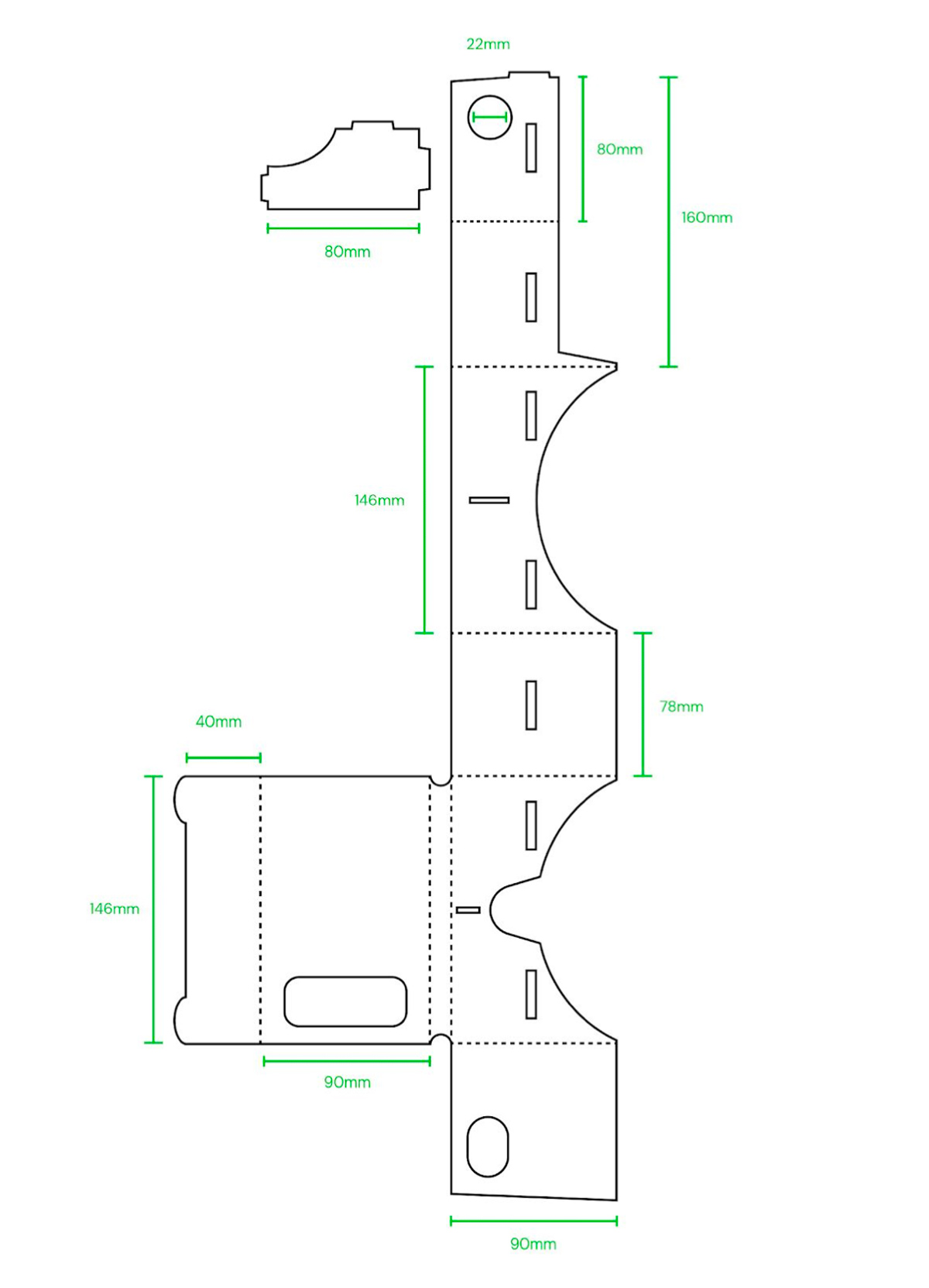
Folding
The body part should be folded from the sides to the inside as follows – following the arrow directions:
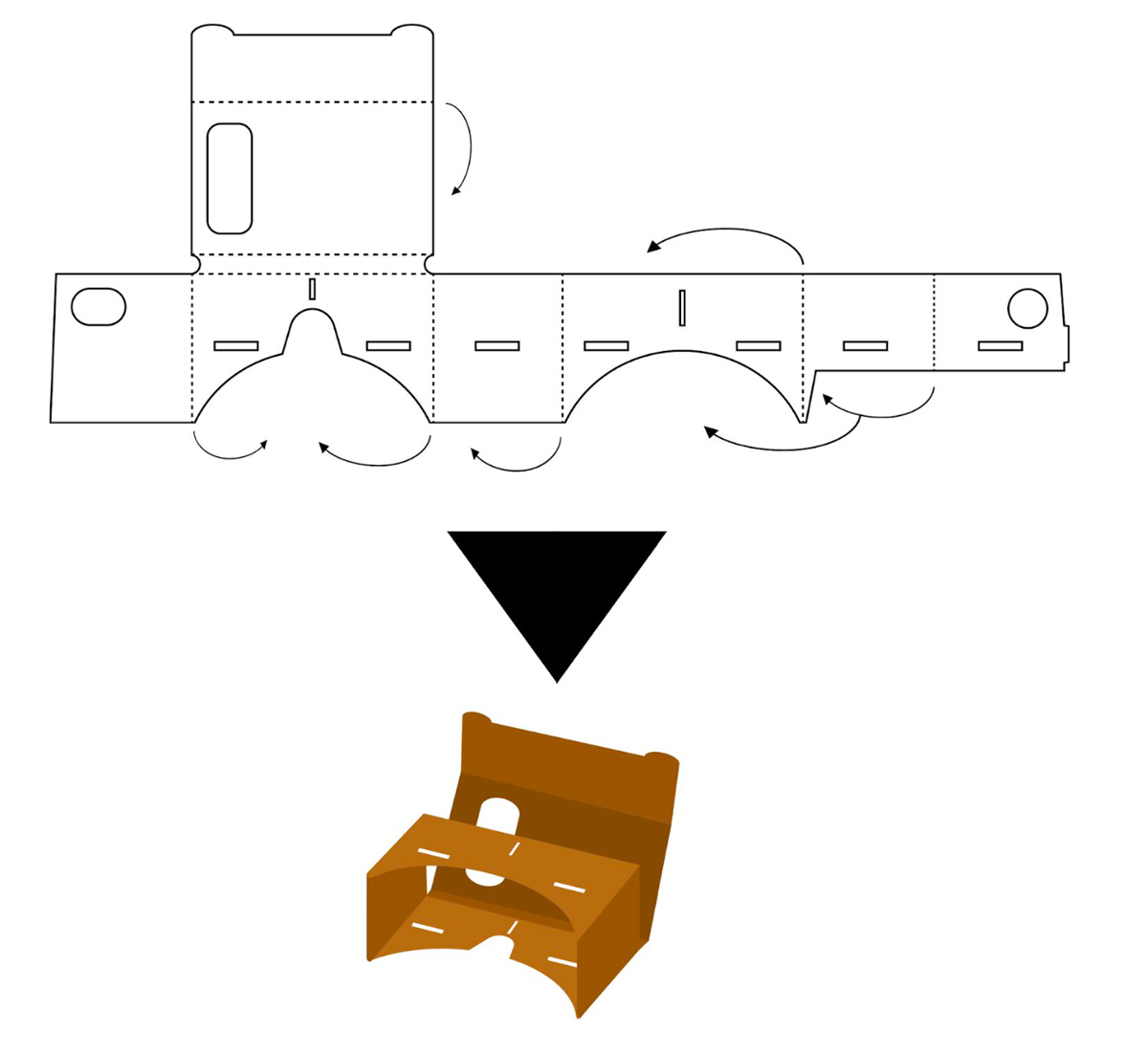
Assembling
To finalize the assembling, follow the following steps:
- Open the body part
- Place the lens holder part flaps in the slots (at the bottom and top)
- Place the phone behind the lens holder – at the back of the body
- Close the body
- You can use a rubber band and velcro tape to secure the body from opening
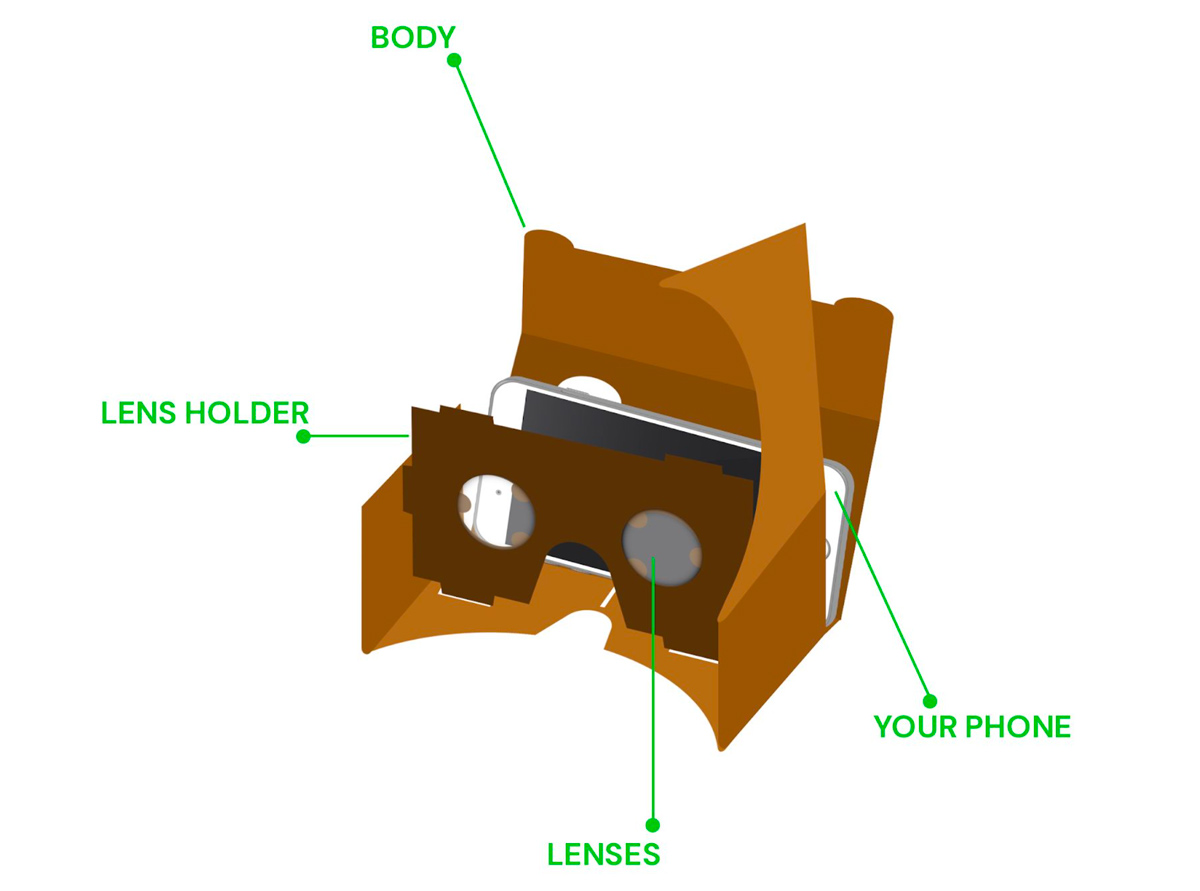
End Product
Below is a prototype of the final product – compared to the original one.
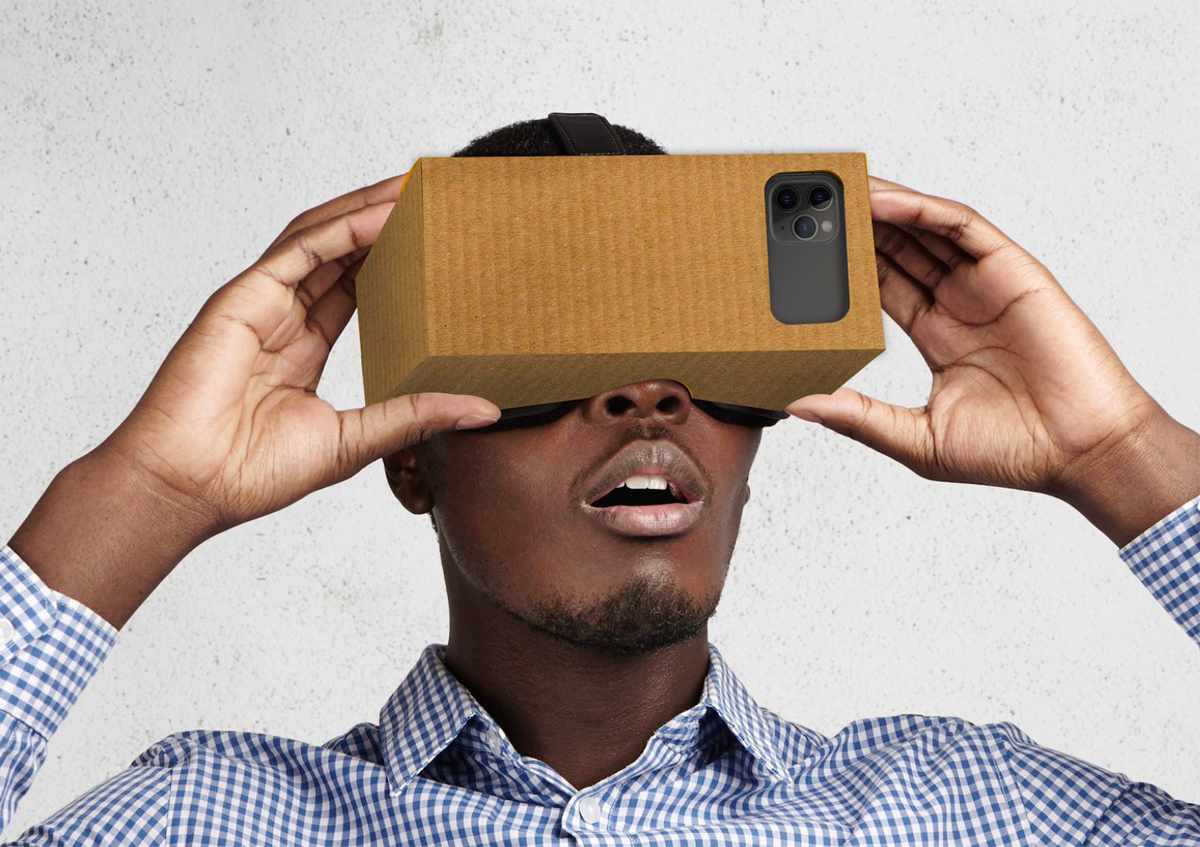
Sustainability Performance
The concept for reusing cardboard boxes is to turn them into an useful item that can be used by almost everyone especially by our young generation who are known in the digital age.
As usage of digital devices are getting higher every day and protruding these devices have negative impact on environment such as causing air and water pollution, depletion of natural resources and producing e-waste (EdinburghSensors, 2020), reuse of a current waste and turn it to a digital application form would help global sustainability and could bring positive impact on our environment, society and economy.
Environment
Cardboard boxes are made of papers which are from trees. In order to produce cardboard boxes, industries have to cut trees from forests and turn them into cardboards. This process can be against sustainability and harm nature as making one ton of virgin cardboard requires three tons of trees (Earth911, 2020).
Trees are vital for us and our planet. Trees help improve air and water quality by absorbing pollutants, releasing oxygen, intercepting particulates, reducing soil erosion and reducing ozone levels (TreesSG, 2019). This means, producing more cardboard boxes can be fatal for the environment as cardboard boxes are produced from trees.
Cardboard boxes can be recycled after the use if they are in a good quality for recycling, but in fact the rate of recycling for this matter is quite low. The unrecyclable cardboard boxes will go for incineration or will be thrown away to landfill sites as waste which could harm our environment and be dangerous for humans as well as for the other creatures.
Other than cardboard boxes, VR gears are made of plastics. Plastics are considered as one of the most dangerous wastes as they contain toxic substances and can pollute the environment, the air and the groundwater (Parker, 2019).
Reuse of this material will help us decrease the rate of production for cardboard boxes which will help our environment to be protected as the industries will require less demands for cutting the trees. It will also narrow down the rate of VR gadget production which uses plastics.
Economy
Cardboard boxes are used mostly for packaging by industries and households. Producing cardboard boxes is considered costly as it requires its own production line, it also requires processing such as raw material production, design, printing, folding and shipping (Corrugated Cardboard, 2020).
Packages made from cardboard boxes can be costly in production. The cost of the packaging as a percentage of total selling price varies greatly. This cost ranges from 1.4 percent to 40 percent (Berger, 2020) which means the product’s final price will be affected because of packaging.
Recycling cardboard boxes also requires lots of preparation and process which are costly. Recycling this material consumes energy and resources and sometimes the consumption of energy and resources can be even more than the original production’s cost.
Reuse of cardboard boxes can prevent the production cost as well as the recycling expenses and save the economy. The conversion of this material to a VR gear gadget will also help save the economy on the other side of the industry which is the production of VR gear.
VR gear price ranges are from RM 80 to 3,000. They are usually made of plastic and other chemical materials which are not considered as environment friendly substances. VR gears are also not upgradable, which means when a new technology comes out, you will need to throw your current VR gear and buy a new upgraded one. This is against global economy and sustainability.
The use of VR headset is getting more popular as its application is spreading. The number of VR gadgets shipped or sold globally is calculated over 5 million units for the year 2019 its estimated to be over 30 million until 2025 (Statista, 2019).
Converting cardboard boxes to VR gears can prevent these issues and boost the economy in future.
Social
Other than the economical and environmental impact of reusing products and preventing them from becoming waste, the conversion of materials such as cardboard boxes and making them reusable again, will help educate the society especially the young generation to consider global sustainability and teach them how to reuse and turn waste to an useful item by a simple conversion.
It also can help the society in the area such as hygiene and health. However VR gear and headsets are usually a personal gadget, due to the price of the product, these gadgets are being shared between people and especially during the events and promotional showcases. This will increase the risk of transmitting germs and spreading viruses amongst the society which could be dangerous during pandemics such as COVID19 (Rogers, 2020).
Sharing a VR headset between two or more people can easily spread germs especially with skin problems as the gadget will be worn on people’s heads and sit on their faces directly.
By making your own VR headsets from cardboards which require a very low budget, you will not need to share a VR gadget with other people and so the risk of transmitting and spreading germs and viruses stays at a very low level.
The simplicity and the ease of making a VR gadget from cardboards will also help you make a new VR gear quickly in the case that your current one is dirty or broken.
VR headsets weight varied from 380 and 700 grams, but a cardboard made VR gear would weigh lighter (20 to 150 grams).
The long-term outlook for VR usage is very positive. It is predicted that the usage of VR gadgets will get more popular and replace the use of personal computers (Bajarin, 2016). Currently, people use this gadget for education and entertainment purposes especially during the pandemics such as COVID19 since it is safer to use as it lets you experience a virtual face to face communication without traveling and having no physical contact (Carosella, 2020).
Conclusion
To consider sustainability, it is necessarily to practice reusing and conversion of waste or unusable items and turn them into a new useful product. It is also important to educate young people and the new generation to consider reusing and conversion.
The current young generation is a tech-savvy and is into modern technology. As explained in this report, some simple and traditional waste such as cardboard boxes which could harm our environment and affect our economy and society as a waste, could be easily converted to a new modern usable product and be reused for purposes like entertainment and education.

Comments